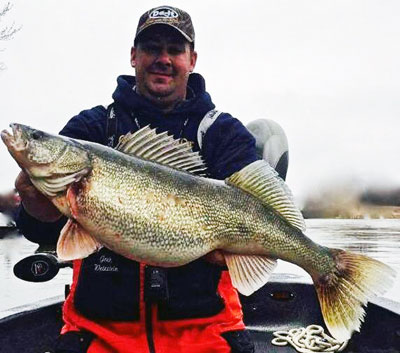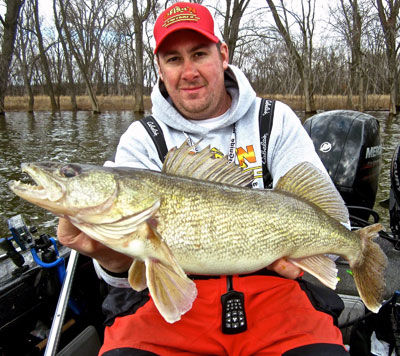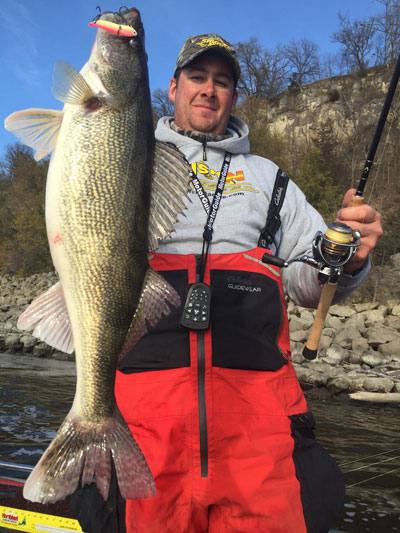By Jim Edlund
Although obsessed with big walleyes, Minnesota guide Josh Wetzstein is pretty humble about statistics. “I haven’t measured a fish in years. Walleyes or muskies. Hold ‘em up, snap a photo and put ‘em back in the water,” says Wetzstein.
Like the sag-bellied monster (in the cell phone image below), caught Friday, March 18th on Pool 4 of the Mississippi River, which Wetzstein “guesstimates” was in the neighborhood of 12 pounds. “They had just opened the roller (gates) and it started snowing when I caught that fish. The water came up quick and fish started scrambling. Came together just right and she bit,” laughs Wetzstein.

Wetzstein’s March 18th monster, “guesstimated” at somewhere around 12 pounds.
He was pitching a chartreuse B FISH N Moxi on a 3/16-ounce white H20 Precision Jig Head. “I like H20 Precision Jig Heads but when you burn through as many jigs as I do, well, you make your own, too. I probably have 50 or 60 Do-It molds.”

The B FISH N Tackle Moxi comes in 3- an 4-inch sizes and 18 colors.

B FISH N Tackle’s new H2O Precision Glitter Series Jig Head comes in nine weights and six colors.
But more on that later.
Though humble, Wetzstein is also opinionated. “In my river experience, 90-percent of the big fish are caught in 10 feet or less. I'll pull Dubuque rigs in 6' to 15', but I prefer to pitch plastics in shallow water.”
He continues: “You’ve gotta get out of the fast current. The big fish aren’t there. Find a point, a rock pile. Get down current. That’s where the big fish are. I jump around using my bowmount, jogging up and down, pitching riprap, wood, current seams, whatever. Electronic anchoring is key.”
And electronics? “The big thing is knowing where you can motor, where you can’t. Otherwise, it’s about reading the river, looking for current seams, inside and outside bends, eddies, and working riprap.”
Some days yield big fish, while others don’t. Not a big deal to Wetzstein, whose other passion is muskie fishing, although he catches his share of respectable mid-sized walleyes, too. “Besides the big fish this past weekend, we caught probably thirty fish between 18 and 26 inches. And lots of milking males,” says Wetzstein.

Wetzstein uses a B FISH N Tackle Ringworm as an early-season search bait.
But it’s the anticipation that the next cast could connect with a 30-incher that keeps him swinging. And right now – from water temps of 40 degrees through 50 degrees – he’s pitching a B FISH N Tackle Ringworm to find fish, then sizing up to a Moxi. “Beefier profile plastics like the Moxi just do better on big fish this time of year.”
Pitching Pointers
“I usually pitch upstream and let the flow sweep my bait down past the boat,” Wetzstein says.
The best tip, he adds, is to remember the exact location of your pitch just before the bite occurs. “You might catch a fish as your jig and plastic moves right in the front of the boat, but don’t cast back to where you got bit. Pitch right back to the exact spot where the jig hit the water before you got bit. That’s where I see guys messing up.”
And cadence?
“It kind of depends on the day, but I usually cast upstream and lift the jig off bottom, reel in slack, and keep the line tight as the current sweeps the jig. Then repeat when the jig hits bottom or lightly shake the rod tip as I reel in slow.”
And if he finds fish, he’ll move on after 20 or 30 minutes. “I don’t like to beat up on the fish too much. Some guys will sit on ‘em all day, but I like to move on to a fresh spot, let the spot refill and come back later.”

Although he’ll pull Dubuque rigs or vertical jig, Wetzstein’s favorite early-season game is pitching plastics shallow.
Like a Plumber
“Thing is, you’ve gotta bring the motherlode with you when you go fish the river. Think of it this way, it’d be like a plumber showing up to fix your sink with nothing but a Channellock pliers. Sure, you might be able to fix it, but you can do a better job by bringing all your tools.”
For Wetzstein, a ‘better job’ equates to a dozen rods or more – 6’8” to 7’ St. Croix Legend Elite and G Loomis NRX with extra fast actions – all rigged with different line types in different diameters and test. He also totes vast variations in jig head styles and weights, and myriad profile and color plastics. Plus, a few more sticks are rigged with various size blade baits and hair jigs.

A bladebait like the B FISH N Tackle B3 is another essential bait in any early-season river walleye tool kit, especially for high, muddy water.
During spring and fall, Wetzstein typically pitches jigs tied direct to 10 – 15 lb. PowerPro braid or 10 lb. NanoFil and 15-lb. fluoro leader so he can free baits from snags without wasting time re-tying. But when it’s really cold and the water clears, he opts for 6 or 8 lb. Berkley Sensation thin-diameter monofilament (high-vis green), which doesn’t freeze up his guides.
Wetzstein fine-tunes his presentation not only with jig size, but also line diameter and bait profile. “You might have to go from a lighter line to a heavier braid – or vice versa – to get the right rate of fall to trigger bites, which changes from day to day. Same goes for soft plastic baits. Cut off an inch or two – or size up. Again, there are a lot of factors at play. Don’t assume the fish aren’t biting if you don’t catch them on one bait. I see guys run around fishing a ¼-ounce jighead and the same color plastic, but don’t catch fish and go home. When you fish the river you have to experiment with jig weight, plastic profile, color, line; a whole bunch of different factors.”
Along the same lines, he’s believes too many river anglers play it safe. “Don’t be scared to cast into the wood and sticks. Walleyes feel safe there; they’ll even spawn in there. Boggles my mind that you have guys in $50,000 boats who cringe at losing a bait. Burn through jigs if you have to.”
Given the conditions on Pool 4 right now, Wetzstein says 3/16 oz. jig heads are about right for pitching, but there’s always a fine line between getting bit and getting snagged.
“Think of it this way, if you can’t fish a 3/16 oz. jig right now, you’re probably in the wrong spot. But when the water drops back down I’ll switch to an 1/8-ounce.”
And for the really snaggy spots, he recommends jigs like a B FISH N Tackle Draggin’ Jig. “If the wood is really gnarly, these jigs do the job. I’m always surprised how many big fish I catch way back in wood.”

Pitching walleyes in wood is made easier with the snag-resistant B FISH N Tackle Draggin’ Jig.
And when to comes to his favorite Moxis, he sticks to fluorescents and the occasional dark pattern for dirty water, and natural colors like ‘oyster shell’ for clear water.
Besides brighter colors during high, muddy water, Wetzstein recommends changing cadence to full-on, aggressive rips. “Vibration is the deal during low visibility, so you have to rip aggressively to let walleyes know the bait is there. Along the same lines, don’t be afraid to grab a blade bait or hair jig, too.”
Guide Contact info: Josh Wetzstein, Walleye Breath and Muskie Hunter Guide Service
(507) 202-2222
https://www.facebook.com/Walleye-Breath-and-Muskie-Hunter-Guide-Service-1635677056715598/?fref=ts


 Canadian Dollar
Canadian Dollar


